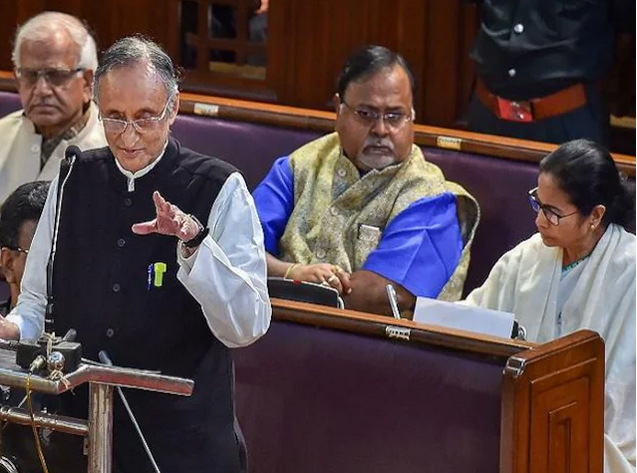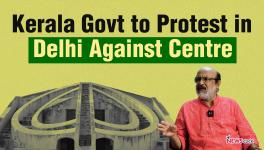Bengal Budget Aims to Better State Finances, Trim Subsidies

Image Courtesy: Business Standard
Kolkata: West Bengal’s budget for 2022-23 aims to make a qualitative change for the better in the state’s financial position – which is to bring down subsidies as a proportion of its expenditure to 4% from 7% in 2021-22, as per the revised estimates (RE).
If the state government succeeds in this attempt, being made keeping in view the softening of the COVID-19 pandemic blow, it will help Nabanna (the state secretariat) to earmark larger outlays for capital expenditure, that is, broadly for creation of assets.
Economists, who study budget proposals carefully, usually differ in their interpretations and West Bengal’s budget, therefore, is no different for them. An exception, or rather a meeting point, is the need for industrialisation, say some economists, such as Ashok K Lahiri, a former chief economic adviser to the Union finance ministry and currently a Bharatiya Janata Party MLA in West Bengal and Abhirup Sarkar, retired professor of Indian Statistical Institute.
A striking feature of West Bengal’s economy in recent years is that while chief minister Mamata Banerjee relentlessly pursues her populist measures to secure the stability of the Trinamool Congress ministry, the absence of big ticket investments in industry has not really dented the state’s ability to service surging debts so far. This is because instead of the identity of an industrialised state, which it was till the 1970s, West Bengal has come to be to known as a consuming state and has, therefore, gained from the Goods and Services Tax (GST), which is a consumption-based levy.
The state’s debt burden, which was Rs 1.92 lakh crore when TMC came to power in May 2011, is projected to be Rs 6 lakh crore at the end of this fiscal. The chief minister had then expressed her displeasure that she had to inherit a debt burden of Rs 1.92 lakh crore from the Left Front government and had demanded a special package from the Centre.
The Left Front then had argued that a substantial part of the borrowing was against the state’s small savings in which it had established a record. The amount was meant for development expenditure and, therefore, signified fiscal prudence. But, this contention was rejected by Banerjee.
Lahiri, in an analytical piece on the 2022-23 budget in Business Standard, has pointed out that West Bengal’s debt to gross state domestic product (GSDP) remained well above the 25% limit prescribed in its Fiscal Responsibilty and Budget Management Act 2010 and as amended thereafter. As per Budget Estimates (BE) of 2022-23, it is pegged at 34.23%.
The other point made by Lahiri is that for 48% of its receipts, the state will depend on tax devolution and grants-in-aid from New Delhi. Another 33% is projected to come from borrowings. [Which should mean the state’s own taxes and non-tax revenue will account for just 19% in the receipts].
The state budget documents do not dispute Lahiri’s contention but point out that the debt to GSDP (gross state domestic product) ratio was high at 40.65% in 2010-11 and it declined to 34.41% in 2021-22 (RE). BE for this fiscal is 34.23%.
Sarkar, while agreeing that debt has risen, said the absolute debt figure should not be regarded as a major concern for the state’s economy. Speaking with NewsClick, he said that note had also to be taken of the introduced Government Process Re-engineering and digital initiatives for e-registration, e-filing of returns and e-payment of taxes, which have enhanced the buoyancy. Officially, it has been claimed that West Bengal recorded the highest growth in the number of new registrations in the country under GST.
On the issue of industrialisation, both the economists agree on its urgency for the state’s long-term growth, in which employment generation has to have the highest priority. The former ISI professor said large-scale units by themselves may not account for large-scale employment generation in this highly advanced IT age. But, these help promote significant ancillarisation and provide a fillip for informal sector economic activity, such as, starting of hotels, opening of provision stores, plying of auto rickshaws and other light vehicles for transport in the command areas of large enterprises. These become the means of earning of livelihood for good many families, Sarkar said.
Lahiri has strongly argued for investments in social and physical infrastructure, as that alone will facilitate industrialisation and will be the only way for providing gainful employment to the people in the state with a population density of 1,082 per sq m relative to 382 in the country. Persisting with policies of cash transfers and subsidies is bound to prove unsustainable and result in unpaid bills and unfulfilled promises, the former chief economic adviser to the Union finance ministry, has cautioned.
When asked about the wisdom of monthly cash support scheme, christened Lakshmi Bhandar, for women which, after all, does not result in asset creation, Sarkar told NewsClick: “It is the prerogative of a democratically elected government to decide how it would like to help a large section of the population”. [Under the scheme, financial support is offered at Rs 1,000 per month to women from SC/ST households and Rs 500 per month to general category women through direct cash transfer. Of late, there are reports that the cash transfer under the scheme has fallen into arrears for some three months].
The growth in state’s own tax revenue, according to government documents, has been: 2010-11 : Rs 21,129 crore ; 2011-12 : Rs 24,138 crore; 2012-13 : Rs 32,808 crore; 2013-14 : Rs 35,830 crore ; 2014-15 : Rs 39,412 crore ; 2015-16 : Rs 42,492 crore; 2016-17 : Rs 45,466 crore ; 2017-18 : Rs 57,701 crore ; 2018-19 : Rs 60.732 crore ; 2019-20 : Rs 60,669 crore ; 2020-21 : Rs 60,287 crore (pandemic) ; 2021-22 : Rs 73,905 crore (RE) and 2022-23 : Rs 79,347 crore (BE).
The principal sources of revenue are excise duty and levies on petroleum products. It may be mentioned that West Bengal has not cut levies on petroleum products and despite the reduction of Rs 8t and Rs 6 a litre on petrol and diesel, respectively on May 21, by the Centre and its plea to states to follow suit in respect of their VAT or value added tax.
The same documents have claimed that the state’s revenue deficit to revenue receipts has progressively come down from 36.55% in 2010-11 to 18.73% in 2021-22 (RE) and for the current fiscal it is likely to be 14.28% (BE).
All states are now awaiting a decision on the GST compensation cess, which was available for five years with effect from July 1, 2017. All states want it to be extended with effect from July 1, 2022.
Given that GST revenues have proved a boon for West Bengal, Sarkar agreed it will be a setback to state’s finances if the GST compensation scheme was indeed terminated from July 1.Of course, the other states too would feel the pinch.
The writer is a Kolkata based senior freelance journalist.
Get the latest reports & analysis with people's perspective on Protests, movements & deep analytical videos, discussions of the current affairs in your Telegram app. Subscribe to NewsClick's Telegram channel & get Real-Time updates on stories, as they get published on our website.
























